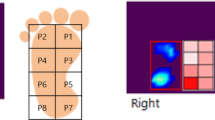Abstract
About half of the people with disabilities in Colombia manifest having impairments in the lower extremities, which requires them to perform any kind of physical rehabilitation, mainly balance recovery sessions. Often, these processes become tedious and monotonous for patients. Therefore, to address this issue, it is necessary to determine how emotional and psychophysiological responses are related to rehabilitation activities. We present a study performed by 13 healthy participants that includes the use of emotional self-reports and simultaneous psychophysiological measuring (15 features extracted) for two balance tasks, one based on regular rehab procedures and the other into a 3D virtual reality game. Results from this study shows that arousal (44%) and valence (24%) as well as heart rate (85%), skin conductance responses (40%) and respiratory rate (80%) outcomes tend to increase in the second task compared to first one. Though preliminary, these results indicate that rehabilitation process carried out through combination of VR environments, serious games and innovative technologies could improve balance recovery sessions, turning them into an enjoyable activity for participants.
Access this chapter
Tax calculation will be finalised at checkout
Purchases are for personal use only
Similar content being viewed by others
References
Ministerio de Salud y Protección Social Oficina de Promoción Social: Sala situacional de las Personas con Discapacidad (PCD) 2018
World Health Organization and the World Bank: World Report on Disability 2011 (2011)
Rastegarpanah, A., Saadat, M., Borboni, A., Stolkin, R.: Application of a parallel robot in lower limb rehabilitation: a brief capability study. In: International Conference on Robotics and Automation for Humanitarian Applications, RAHA 2016 - Conference Proceedings (2017)
Kharboutly, H., Ma, J., Benali, A., Thoumie, P., Pasqui, V., Bouzit, M.: Design of multiple axis robotic platform for postural stability analysis. IEEE Trans. Neural Syst. Rehabil. Eng. 23, 93–103 (2015)
Patanè, F., Cappa, P.: A 3-DOF parallel robot with spherical motion for the rehabilitation and evaluation of balance performance. IEEE Trans. Neural Syst. Rehabil. Eng. 19, 157–166 (2011)
Schouten, A.C., Boonstra, T.A., Nieuwenhuis, F., Campfens, S.F., Van Der Kooij, H.: A bilateral ankle manipulator to investigate human balance control. IEEE Trans. Neural Syst. Rehabil. Eng. 19, 660–669 (2011)
Roth, E., Mitra, R.: Chapter 10: stroke rehabilitation. In: Principles of Rehabilitation Medicine. McGraw-Hill Education, New York
Gobron, S.C., et al.: Serious games for rehabilitation using head-mounted display and haptic devices. Springer, Cham, pp. 199–219 (2015)
Van Diest, M., Lamoth, C.J., Stegenga, J., Verkerke, G.J., Postema, K.: Exergaming for balance training of elderly: state of the art and future developments. J. Neuro Eng. Rehabil. 10, 101 (2013)
Kim, H.K., Park, J., Choi, Y., Choe, M.: Virtual reality sickness questionnaire (VRSQ): motion sickness measurement index in a virtual reality environment. Appl. Ergon. 69(October 2017), 66–73 (2018)
Bradley, M.M., Lang, P.J.: Measuring emotion: The self-assessment manikin and the semantic differential. J. Behav. Ther. Exp. Psychiatry 25(1), 49–59 (1994)
Goljar, N., et al.: Psychophysiological responses to robot training in different recovery phases after stroke. In: IEEE International Confernce on Rehabilitation Robotics (2011)
Acknowledgment
This research received financial support from Universidad Militar Nueva Granada, as part of the research project IMP-ING-2657.
Author information
Authors and Affiliations
Corresponding author
Editor information
Editors and Affiliations
Rights and permissions
Copyright information
© 2020 Springer Nature Switzerland AG
About this paper
Cite this paper
Caldas, O.I., Abril, J.D., Rivera, O., Rodriguez-Guerrero, C., Avilés, O.F. (2020). Contribution of Virtual Environments to the Perception of Balance Rehabilitation Tasks: A Psychophysiological Study. In: González Díaz, C., et al. VIII Latin American Conference on Biomedical Engineering and XLII National Conference on Biomedical Engineering. CLAIB 2019. IFMBE Proceedings, vol 75. Springer, Cham. https://doi.org/10.1007/978-3-030-30648-9_156
Download citation
DOI: https://doi.org/10.1007/978-3-030-30648-9_156
Published:
Publisher Name: Springer, Cham
Print ISBN: 978-3-030-30647-2
Online ISBN: 978-3-030-30648-9
eBook Packages: EngineeringEngineering (R0)




